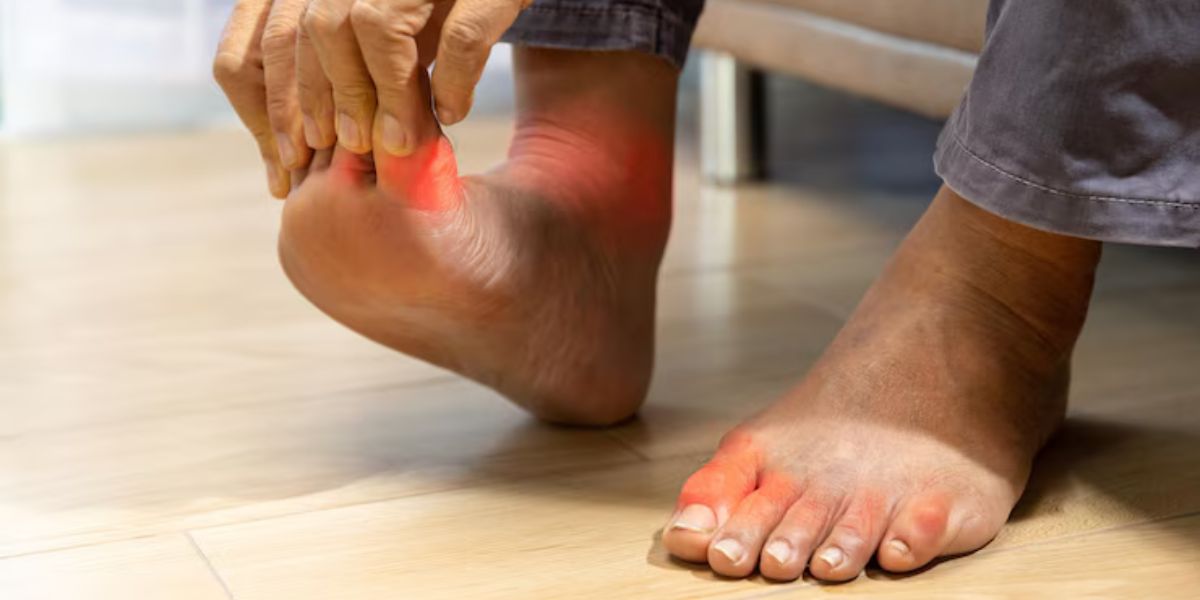Foot pain can be frustrating, especially when you’re not sure what’s causing it. Two common issues—gout vs bunion—often get confused because both affect the big toe and cause discomfort. But they’re not the same. While one is a joint inflammation problem, the other is a bone deformity. Knowing the difference between bunion and gout is key to proper care. If you’ve noticed redness on the big toe, swelling, or a visible bump, understanding your symptoms can help you choose the right treatment. In this guide, we’ll explore bunion or gout pain, how each condition develops, and what you can do to feel better, faster.
How to Know If It’s a Gout Flare or a Bunion Problem
Many people struggle to tell if their foot pain is from gout or a bunion. Gout usually comes on suddenly, with intense pain, often at night. A bunion, however, develops slowly over time and often looks like a bump on the side of the big toe.
The main difference between bunion and gout is the type of pain and where it starts. Gout feels sharp and comes fast, while a bunion causes ongoing discomfort. Understanding whether it’s bunion or gout pain can help you seek the right care sooner.
Major Differences Between Gout and Bunion Pain
Gout pain is often sudden and severe. It can cause redness on the big toe and make the joint feel hot to the touch. Bunions cause more of a dull, aching pain that worsens when walking or wearing tight shoes.
A gout flare vs. bunion discomfort can also be felt differently. Gout pain feels like stabbing, while bunion joint pain feels more like pressure and stiffness. Gout often affects one joint at a time, but bunions affect the entire toe area.
What Causes Gout vs. What Causes a Bunion?
What causes gout is the uric acid buildup in joints. This happens when the body makes too much uric acid or can’t get rid of it properly. It forms sharp crystals in joints and causes pain. Foods high in purines like red meat and alcohol can be gout causes and triggers.
What causes a bunion is different. Bunions are usually caused by bunion causes and risk factors such as wearing tight shoes, genetics, or having flat feet. Pressure on the toe joint over time pushes the bone outward, creating a bump and pain.
Early Stage Gout vs. Bunion: What to Watch For
In the early stage, gout symptoms in foot include mild pain, slight redness, and discomfort after eating certain foods. These signs often appear in the big toe and can come and go. Sharp pain in toe joint might be your first clue.
The early signs of bunion include the toe leaning inward and slight swelling. There may not be much pain at first. But the pressure grows slowly. If you notice your big toe shifting, it might not be gout. It could be a bunion forming.
Big Toe Gout vs. Bunion: Location, Swelling & Sensation
Bunion vs. gout toe location helps tell them apart. A bunion forms on the side of the toe, while gout in big toe affects the joint at the base. Gout usually feels warm and looks very red. Bunions look more like a hard bump.
You might feel swelling in bunion or gout, but in gout, it’s soft and spreads. With bunions, it’s firm and centered. Gout can make walking nearly impossible, while bunions just make it uncomfortable over time.
Can You Have Both Gout and a Bunion at the Same Time?
Yes, it’s possible. Some people can have both gout and bunion on the same foot. That’s why getting a correct diagnosis matters. The treatments are different. One needs lifestyle changes and medicine, while the other might need surgery or shoe changes.
When both occur, the symptoms overlap. You may feel chronic foot swelling with bunion or gout pain at the same time. Always tell your doctor all your symptoms. It helps in finding the best solution.

Diagnosis Process: How Doctors Confirm Gout or Bunions
Diagnosing gout involves a blood test for gout and possibly a joint fluid test for gout. These tests look for uric acid buildup in joints or crystals. A rheumatologist for gout may also ask about your diet, symptoms, and family history.
Diagnosing bunions usually means a foot exam and x-ray for bunion. This helps the doctor see how far the toe has shifted. A podiatrist for bunion checks your walking pattern and foot shape to decide the next steps.
Treatment Options: Gout Medication vs. Bunion Relief
How to treat gout flare-ups includes using gout medication options like NSAIDs, colchicine, or steroids. Some people also try home remedies for gout, like cherry juice or limiting purines. Managing gout through diet can reduce flares over time.
For bunions, bunion treatment USA options include shoe changes, padding, and rest. How to treat bunion pain depends on the size and pain level. Some go for non-surgical bunion relief, while others need bunion surgery options when the pain becomes unbearable.
What Does an Inflamed Bunion or Gout Attack Look Like?
An inflamed bunion is red, swollen, and may have painful bunion swelling when touched. The skin looks stretched, and shoes may no longer fit. There’s constant discomfort while standing or walking.
In a gout attack, you’ll see sudden swelling and intense pain. It may be hard to move or even touch the area. The skin over the joint looks shiny. These gout attack signs come quickly and fade slowly over days.
Final Takeaway
Knowing the difference between bunion and gout is key to recovery. Both need different care plans. Whether it’s surgical vs non-surgical bunion care or treatment options for bunions and gout, only a doctor can help you choose.
If you’re unsure when to see a doctor for foot pain, don’t wait too long. See a foot pain specialist in the USA to get tested and begin healing. Your feet carry you every day—treat them with the care they deserve.
FAQs
How do I know if I have a bunion or gout?
Gout causes sudden, sharp pain with redness at the joint, while a bunion shows a slow-growing bump on the side of the big toe.
What do your feet look like if you have gout?
Your foot may appear swollen, red, shiny, and very tender—especially around the big toe joint.
Is bunion due to uric acid?
No, a bunion is caused by bone misalignment, not uric acid buildup, which is linked to gout.
What does a bunion flare up look like?
A bunion flare-up appears as increased redness, swelling, and throbbing pain around the bony bump of the big toe.

